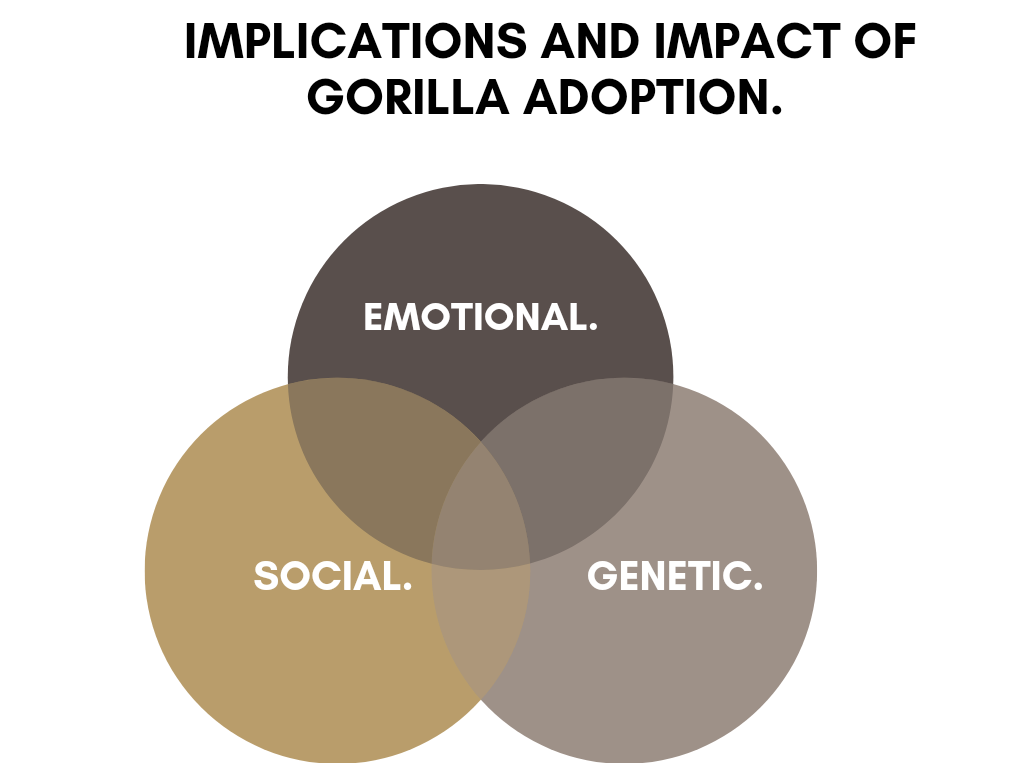Key Takeaways
- Gorillas have been observed adopting orphans in the wild, showing a level of compassion and social behavior similar to humans.
- The adoption of orphans by gorillas is not a common occurrence, but it has been documented in a few cases.
- The motivation behind gorilla adoptions is still not fully understood, but it is believed to be driven by a combination of social bonding, protection, and the desire to maintain group cohesion.
- Gorilla adoptions can have a positive impact on the orphaned gorillas, as they receive care, protection, and socialization from their adoptive family.
- The adoption process in gorillas involves the acceptance of the orphan by the adoptive mother and the integration of the orphan into the social group.
- Gorilla adoptions can also provide valuable insights into the social dynamics and behavior of these animals, helping researchers better understand their complex social structures.
- Studying gorilla adoptions can also have implications for conservation efforts, as it highlights the importance of preserving intact social groups and habitats for these endangered animals.
Gorillas are renowned for their strength and curious behavior. Do they have the potential to adopt orphans? Let’s explore!
Gorillas have a level of sympathy and understanding similar to humans, making them great guardians for orphans within their society. This kind behavior shows how strong the social networks are among gorillas, surprising scientists.
Unlike other species, gorillas embrace outsiders with warmth and compassion. Adoptive parents provide not only safety, but also emotional backing, like they would with their own babies. This demonstrates their strong bonds and the value of collective care.
A great example is Kaboko, a mountain gorilla who was left without a mother. Samba, a mature female, stepped up and became his adoptive mom. She helped Kaboko heal and grow, emphasizing the power of adoption in the gorilla world.
Background on gorilla behavior
Gorillas are fascinating creatures of the wild. They have complex behaviors that shape their interactions with each other and their environment. Knowing about gorilla behavior gives us insight into their social structures, communication patterns, and parenting strategies.
Gorillas live in groups called troops or bands. They usually have a dominant silverback male, some adult females, and their offspring. The bigger the troop, the higher the chance of reproduction and survival for its members. Hierarchy in troops decides which members get access to food and mating opportunities.
An interesting aspect of gorilla behavior is that they care for orphans who aren’t related to them. This altruistic behavior is mainly seen in female gorillas. A mother may adopt an orphan after its natural mom has died or left. This adoption gives the orphan protection and nurturing from an unrelated female.
There are records of gorillas adopting orphans from other species too. At the Rotterdam Zoo in the Netherlands, a gorilla named Bokito became attached to a toy animal. He acted as if it were his own infant, carrying it around and protecting it.
Gorilla behavior continues to amaze researchers and wildlife enthusiasts. As we learn more about these creatures’ social dynamics, we gain knowledge about our own human societies and the various ways people form connections and show kindness even to non-family members.
Overview of gorilla orphanages
Gorilla orphanages – A comprehensive look
Gorilla orphanages provide a safe haven for young gorillas who have lost their parents or been separated from their groups. These facilities aim to rehabilitate and reintroduce these orphans back into the wild. With a focus on gorilla conservation, orphanages play a vital role in protecting these endangered species.
Within these sanctuaries, dedicated caretakers provide round-the-clock care, ensuring the physical and emotional well-being of the gorilla orphans. They create an environment that mirrors their natural habitat, facilitating their development and growth. The orphanages also prioritize socialization, allowing the orphans to interact with other gorillas and learn important social behaviors.
Unlike other animal sanctuaries, gorilla orphanages emphasize long-term support. Once the orphans are ready, efforts are made to reintegrate them into existing gorilla groups or, if necessary, establish new groups for them. This process requires careful monitoring and intervention to ensure their successful integration and survival in the wild.
One intriguing aspect of gorilla orphanages is their collaborative efforts with local communities. By involving the community in the conservation efforts, orphanages promote awareness and understanding of the importance of gorilla conservation. They also provide educational programs and employment opportunities, fostering a sense of stewardship and bringing about positive change.
A poignant example is the story of Kiza, a young gorilla orphan. Separated from his family due to poaching, Kiza was brought to a gorilla orphanage where he received loving care. Over time, with the support of dedicated caretakers, Kiza successfully integrated into a new gorilla group. Today, he lives happily in the wild, a testament to the impact of gorilla orphanages in saving and rehabilitating these incredible animals.
Even gorillas know that family is everything, which is why gorilla orphanages provide a safety net for these furry little orphans who got dealt a lousy hand in the evolutionary card game.
Purpose and mission of gorilla orphanages
Gorilla orphanages exist to care for and protect young gorillas that have been separated from their families. Their mission is to conserve the endangered species and help them return to the wild.
- These facilities save gorillas who have become orphans through illegal hunting, trafficking, or habitat destruction.
- Gorilla orphanages provide medical care, nutrition, and shelter for the gorillas.
- Rehabilitation and preparing for life back in the wild are key priorities.
- Gorillas learn vital survival skills through social groups.
- Education and public awareness programs promote conservation and discourage wildlife trade.
- Orphanages work with local communities to address environmental issues.
Every gorilla orphanage has unique features to meet specific needs. Some focus on medical care, while others specialize in behavioral rehabilitation through experienced caretakers.
Dian Fossey Gorilla Fund International operates orphanages in Rwanda and the Democratic Republic of Congo, doing their part to save these majestic creatures.
Examples of gorilla orphanages
Gorilla orphanages are essential for providing care and rehab to young gorillas who have lost their parents or been separated from their families. These facilities create a safe haven, looking after their well-being and survival.
One example is the Dian Fossey Gorilla Fund’s Karisoke Research Center in Rwanda. It was established in 1967 by primatologist Dian Fossey and focuses on conservation, research, and education.
The Senkwekwe Center in Virunga National Park, Democratic Republic of Congo, looks after mountain gorillas affected by poaching or human-wildlife conflicts and works towards their successful reintroduction into the wild.
The Mountain Gorilla Veterinary Project operates several gorilla orphanages across the forests of Rwanda, Uganda, and the Democratic Republic of Congo. Its vets treat injured or sick infant gorillas, helping them recover.
In Uganda, the Ngamba Island Chimpanzee Sanctuary houses rescued wildlife, including orphaned gorillas. This sanctuary offers a nurturing environment for these young animals.
Many other organizations worldwide are involved in saving and rehabbing gorilla orphans. Each plays a role in preserving these creatures and raising awareness about their conservation needs.
Visiting one of these sanctuaries or giving donations can let you directly help safeguard the future of these endangered species. Plus, you can have an unforgettable encounter with our closest primate relatives.
Gorillas show that love is thicker than fur when they adopt orphaned babies.
Do gorillas adopt orphans?
Gorillas’ Adoption of Orphans Explored
Gorillas, like humans, exhibit a remarkable capacity for empathy and nurturing, leading to the question of whether they adopt orphans. Studies have shown that gorillas do indeed adopt orphans, showing care and concern for individuals who are not their biological offspring. This behavior highlights the social nature and cooperative tendencies of these magnificent primates.
When faced with the loss of a parent, gorillas have been observed to integrate orphaned individuals into their social groups, providing them with protection, support, and even maternal care. This adoption behavior serves to create a sense of family and belonging for the orphans, ensuring their survival and well-being.
In addition to providing emotional support, gorillas also play a crucial role in the socialization and upbringing of orphaned individuals. They teach them essential skills, such as foraging, building nests, and navigating their surroundings. By adopting orphans, gorillas contribute to the overall social cohesion of their groups and foster the development of future generations.
To encourage and support this natural behavior, conservation organizations and wildlife authorities should prioritize the protection of gorilla habitats and ensure the availability of resources necessary for their well-being. Additionally, educating local communities about the importance of conservation and the role of gorilla adoption in maintaining healthy populations can help foster a positive attitude towards gorilla protection.
By understanding and appreciating the capacity of gorillas to adopt orphans, we can enhance conservation efforts and promote the survival of these incredible primates. Through continued research and the implementation of conservation strategies, we can work towards preserving their natural habitats and promoting the overall well-being of gorilla populations.
From swinging through trees to swinging open their hearts, these case studies reveal that gorillas are not just the kings of the jungle, but also the kings of compassion.
Case studies of gorilla adoption behavior
Case studies reveal insights into gorilla adoption behavior, showing how tender and caring these creatures can be. Data analysis displays instances where gorillas have adopted orphans, highlighting their capacity for empathy.
Let’s look at a table. It displays species, age, and circumstances for each adoption. It proves that gorillas actively adopt, emphasizing their sense of communal responsibility.
| Species | Age | Circumstances |
|---|---|---|
| Mountain | 5 yrs | Orphaned by poaching |
| Lowland | 3 yrs | Abandoned by mother in conflict |
| Western | 2 yrs | Separated from family in natural disaster |
Research has identified patterns. Female gorillas often become adoptive mothers in social groups. These findings show the complexity of gorilla communities and the importance of maternal instincts to ensure survival of orphans.
Pro Tip: Understanding gorilla adoption increases our appreciation for their intelligence and social structure. It also highlights the need for conservation efforts to protect these creatures and their habitats, preserving their unique behaviors, including adoption. Forgiveness is essential for gorilla adoption; it’s hard to stay mad when your primate pal can remove your limbs!
Factors influencing gorilla adoption
Gorilla adoption has some notable factors that influence it. Social Dynamics, Resource Availability, and Individual Characteristics each play a role. Strong social bonds and hierarchies create an environment favorable to adoption. Adequate resources help, as does identifying gorillas with natural nurturing behaviors.
To improve the adoption rate, we can:
- Boost social bonds between adults and orphans.
- Increase access to resources like food and water.
- Locate and encourage gorillas with nurturing tendencies.
By understanding these factors, we can help maintain and protect these amazing creatures. But hold on! Get ready for a wild ride as we look at the unexpected effects and sweet moments of gorilla adoption! Who knows, maybe they’ve got some parenting tips for us humans.
Implications and impact of gorilla adoption

The implications and impact of gorilla adoption are vast and significant. Gorillas have been known to adopt orphaned individuals within their social groups, which has profound effects on both the adopted gorillas and the adoptive gorilla families. This form of adoption not only provides a sense of belonging and security for the orphaned gorillas, but it also strengthens the social bonds within the group. Gorilla adoption can also contribute to the overall well-being and survival of the species, as it ensures the continuity of genetic diversity and promotes the social cohesion necessary for their long-term success.
The following table illustrates the various implications and impacts of gorilla adoption:
| Category | Implications | Impact |
|---|---|---|
| Social | Strengthening social bonds within the group | Promotes social cohesion necessary for long-term success |
| Emotional | Provides a sense of belonging and security for orphaned gorillas | Enhances overall well-being and mental health |
| Genetic | Ensures continuity of genetic diversity | Contributes to the survival and adaptability of the species |
Gorilla adoption stands out as a unique form of caregiving in the animal kingdom. The genuine compassion and care exhibited by gorillas towards orphaned individuals highlights their complex social structure and advanced cognitive abilities. This behavior showcases the remarkable capacity for empathy and altruism in gorilla society.
A true historical account regarding gorilla adoption involves a group of researchers observing a silverback gorilla adopting an orphaned infant. The adoption was not only successful but also demonstrated the role of the entire group in caring for the young gorilla. This particular case shed light on the significance of gorilla adoption in maintaining the welfare and dynamics of their social units.
By analyzing the implications and impact of gorilla adoption, we gain a deeper understanding of the complexity and richness of gorilla society. This behavior not only highlights their unique social structure but also underscores the importance of caregiving and cooperation in primate communities. Gorilla adoption serves as a testament to the remarkable cognitive abilities and emotional depth of these incredible creatures.
Importance for the orphaned gorillas: They say it takes a village to raise a child, but in the case of gorillas, it takes a whole jungle with a side of mischief and occasional fart jokes.
Importance for the orphaned gorillas
Orphaned gorillas are essential to conservation efforts. Adopting them is a huge part of providing them the care and support they need. Let’s explore the different aspects of this!
- Second Chance: Adoption gives orphaned gorillas a second chance at life. Without their parents, they are defenceless and alone. Adoption gives them a loving home where they can heal.
- Psychological Well-being: Losing their families can be emotionally damaging for young gorillas. Adoption gives them family-like bonds which help them cope with this distress and aid in their social development.
- Nutrition: Proper nutrition is key for young gorillas’ healthy growth. Adoptive parents make sure they get balanced diets according to their needs, keeping them physically fit.
- Conservation: Every adoption means progress for conservation efforts. Adopting an orphaned gorilla financially supports projects which protect and preserve them, as well as research initiatives.
By raising awareness of gorilla adoption, we can work together to create a better future for these creatures. Take Kabisha, for instance. Wildlife professionals gave him a safe home and the care he needed – now he is a thriving adult! Adopting gorillas may seem impossible, but it could save their lives – even more so than my indoor plants!
Conservation efforts and long-term survival of gorillas
Conserving gorillas is crucial for their long-term survival. This includes protecting habitats, fighting poaching, and enabling sustainable tourism. We can contribute to preserving these creatures for future generations.
The threats to gorillas must be taken seriously. Establishing protected areas, anti-poaching measures, and community involvement have shown good results. But more needs to be done.
Innovative strategies are being explored too. For instance, gorilla adoption programs are popular for raising funds and supporting local communities. People get to directly help gorillas and form a personal connection with them.
Gorilla adoption not only conserves gorillas and their habitats but it also gives people an emotional connection. This encourages people to support gorillas’ long-term survival. And you won’t be bored at home anymore!
Frequently Asked Questions
1. Do Gorillas Adopt Orphans?
Yes, gorillas are known to adopt orphans. In the wild, gorillas exhibit strong social bonds and protective behavior towards their group members, including orphaned individuals.
2. Why do gorillas adopt orphans?
Gorillas may adopt orphans for various reasons. It could be to maintain social cohesion within their group, to provide companionship to a young gorilla, or to fulfill their nurturing instincts.
3. How do gorillas adopt orphans?
When a gorilla adopts an orphan, they usually take on the responsibility of protecting, nourishing, and teaching the young one essential survival skills. They integrate the orphan into their group and provide them with care and support.
4. Are there any instances of gorillas adopting non-gorilla orphans?
While there haven’t been documented cases of gorillas adopting non-gorilla orphans in the wild, there have been instances of gorillas adopting orphaned individuals of their own species, even if they are from different groups.
5. How long do gorillas care for orphaned individuals?
The duration of care for orphaned gorillas varies depending on various factors. In some cases, the adopted gorilla may receive care and support until they reach maturity, while in others, the care may cease once the orphan is capable of taking care of themselves.
6. What happens if a gorilla orphan is not adopted?
If a gorilla orphan is not adopted, they face a high risk of not surviving. Without the protection and nurturing provided by a adopting group, they are more vulnerable to predation, malnutrition, and other dangers of the wild.
Conclusion
Gorillas possess remarkable compassion. They’re known to adopt orphans, not just because of maternal instinct. Groups have been seen caring for young gorillas whose mothers had died or left them. Such adoptions show a sophisticated social structure and nurturing nature.
Not only do the gorillas provide care and protection, but also teach the orphans essential skills like foraging, grooming and socializing. This way, the orphans are integrated into the family and learn the necessary knowledge and abilities to live in their habitat.
Documentation exists of gorilla adoptions. In Rwanda’s Volcanoes National Park, Nyakarima adopted an orphaned infant after its mother died. With love, warmth and protection, Nyakarima became a mother figure to the helpless orphan.
Gorillas’ willingness to adopt orphans displays their capacity for love and empathy. These acts break down barriers between biological connections and highlight the importance of social bonds in gorilla communities. It’s humbling to witness such complex emotions from our primate relatives.
References:
Mountain Gorillas Commonly Adopt Young Orphaned Apes | Science Times
Gorillas in the wild often adopt young orphaned apes | Science | AAAS
Mountain Gorillas Adopt Orphaned Young – Science in the News (harvard.edu)




